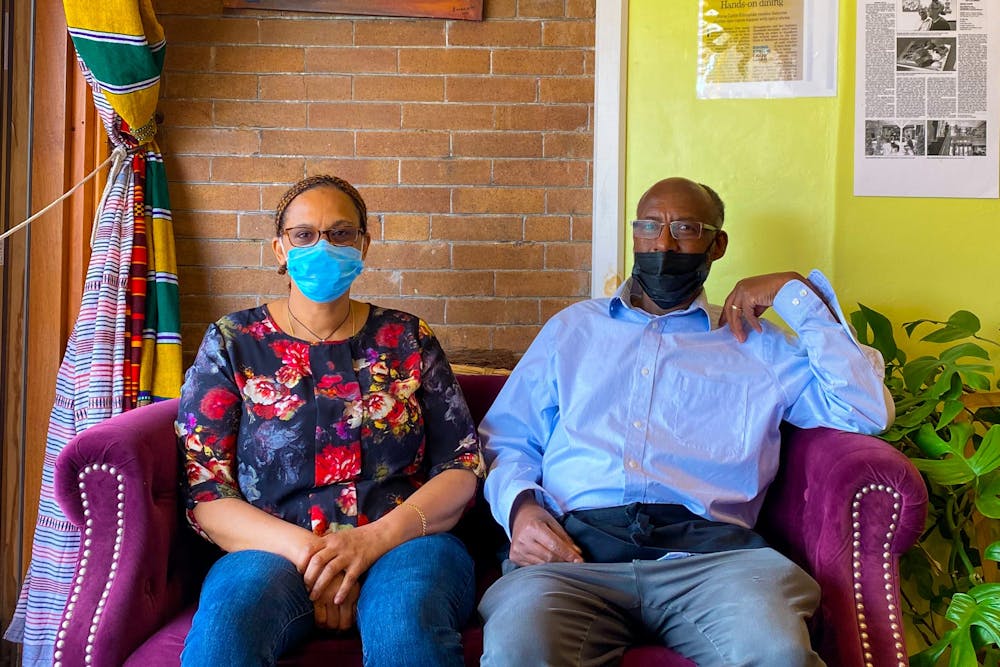I walk into an orange cafe on Baltimore Avenue. It’s brightly lit, sunshine flooding every corner of the area. Ethiopian artwork and drapery in the colors of the country’s flag cover these walls, each contributing to a comforting feel. Color isn’t just an important aspect of Buna Cafe’s decor, it’s also fully embedded into the food, warmth of the hosts, and overall ambience of the place. Classic, colorful Ethiopian food with a vegan and vegetarian emphasis is what you’ll find at these wooden tables, with a food arrangement style straight from a family kitchen.
After getting situated, I grab a dinner menu and order a drink: the aptly named “Gold Is the Cure,” which is a non–caffeinated tea with ginger, turmeric, garlic, basil, and honey milk. The ginger hits as soon as I take a sip, and I feel all my senses being engaged at once. The tea is calming and therapeutic in both smell and taste, preparing me for the upcoming main course.
Then, the star of the evening: a veg combo of a misir (spiced lentil) base with kaye sihr (red beets, potatoes, and yellow onions spiced up), tikil gomen (cabbage, potato, and carrot alicha stir–fry), and regular gomen (chopped collard greens with garlic, onions, and ginger) all served on injera, a kind of Ethiopian flatbread. My first thought after biting into the food is how soft the injera is—it could be eaten as a complete meal on its own, but with the addition of the sides, a whole new confluence of textures and flavors is created. I eat the injera using the intended method of consumption: ripping small pieces and dipping them into different combinations of the kaye sihr, tikil gomen, and gomen. As a lover of beets and potatoes, kaye sihr steals the show. The difference in texture and temperature between the sponginess of the injera and the hot chewiness of the kaye sihr makes for a warm, filling experience.

Photo Courtesy of Sruthi Srinivas
Enjoying my entree, I’m reminded of dosa and daal, both giants of South Indian cuisine. Dosa is also a kind of flatbread, although it’s much crunchier than injera. Daal is more of a catch–all term for potatoes or lentils served with dosa, but it’s eaten in much of the same way as injera—by breaking off and dipping. There’s a vegetarian emphasis in these meals, as there is in the food I gravitate toward at Buna Cafe, so I wonder if there are similarities in this tradition.
“Most Ethiopian food is vegetarian–based,” says Demelash Demissie, co–owner and husband to Chef Belaynesh Wondimagegnehu. “We wanted to offer that for the neighborhood.”
The intention to give back echoes in the way Demissie and Wondimagegnehu interact with their customers. During my time in the cafe, there are multiple people coming in and out. A few nods are enough to convey dishes and drinks and preferred snacks, mostly vegetarian and wholly Ethiopian. Amid the struggles that came with COVID–19, particularly to small businesses, there seems to be a camaraderie between the patrons of the area and the couple: Home–cooked food and a friendly atmosphere is something that all parties want to preserve.
And preserve they do, in both food and character. When I sit and eat at Buna Cafe, despite having no Ethiopian blood or ties, I feel a pleasant familiarity. I look at Demissie and Wondimagegnehu and I think of my own family, of sitting down together on a sunny day and sharing dosa. I eat at Buna alone, but I don’t feel like I’m eating alone. I’m biting down into personal history, heritage, and home.
This is what Buna Cafe offers and more: fairly priced meals, excellent flavors, and a home away from home for the neighborhood. It’s a gem certainly worth checking out the next time you find yourself in the area.







